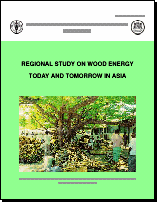

Regional Study on Wood Energy Today and Tomorrow
Field Document No.50, October 1997
 This field document is an outlook on wood energy in Asia up to the year 2010. The study has been prepared by RWEDP staff at the request of the Asia-Pacific Forestry Commission, as a contribution to the upcoming Forestry Sector Outlook Study for the Region.
This field document is an outlook on wood energy in Asia up to the year 2010. The study has been prepared by RWEDP staff at the request of the Asia-Pacific Forestry Commission, as a contribution to the upcoming Forestry Sector Outlook Study for the Region.
The document summarises characteristics of wood energy supply and use, and provides an outlook on wood energy to the year 2010. The document presents a critical review of available wood energy data, leading to best estimates of future consumption. It also tries to estimate the present and future potential supplies of fuels from wood and crop residues. The study shows that in most countries, the actual availability of woodfuels is not the major concern; rather it is their distribution to people in need.
This point leads to recommendations to policy makers on how best to integrate woodfuel supply with other objectives, particularly in the forestry sector. The integration of woodfuel development in other relevant sectors like agriculture and energy is also strongly recommended. The document further calls for efforts to upgrade fuels from crop residues by using cost-effective technologies.
Greenhouse gas implications of wood energy use in RWEDP member-countries are discussed. It is estimated that in 1994 emission of some 560,000 kton of CO2 was avoided by the use of woodfuels as compared to coal as a (hypothetical) alternative. This figure will increase to about 700,000 kton by the year 2010. When capitalised in terms of avoided costs for CO2 abatement, this leads to an indicative figure of 28 billion US$ annually (respectively 35 billion US$).
The study reveals the weaknesses of available data and cautions about scenario development which lacks substantial basis. One of the striking messages is that the future of Asia's tropical forests and the problems of woodfuel users are not as closely linked as is often assumed.
| Table of Contents | |
| Foreword | |
| Executive Summary | |
| 1. | Introduction |
| 2. | Misconceptions About Wood Energy |
| 3. | The "Fuelwood Gap Theory" Rejected |
| 4. | Selected Wood Energy Data |
| 5. | Wood Energy Consumption Patterns |
| 6. | Woodfuel Supply Policies |
| 7. | Estimates of Wood Energy Consumption |
| 8. | Supply and Consumption Outlook |
| 9. | Implications of Woodfuel Use for Greenhouse Gas Emissions |
| 10. | Conclusions and Recommendations |
| Appendices | |
| 1. | Wood and Biomass Energy in the Asia - Pacific Region |
| 2. | Table: Correlation Between FAO-published Data for Total Fuelwood Production and Population in RWEDP Member Countries, 1964-1994 |
| 3. | References |
| Boxes | |
| 1. | The Fuel Ladder |
| 2. | Fuelwood in Agroforestry |
| 3. | Good News? |
| 4. | R&D For Residue Combustion |
| 5. | About RWEDP |
| A1. | Definition of Combustible Renewables and Wastes, as Proposed by IEA |
| A2. | Database Systems on Energy Including Biomass in Europe versus Asia and the Pacific |
This document is available as a single, complete file in Adobe Acrobat PDF format suitable for downloading, printing, duplication and distribution. (To download the free Acrobat Reader and find out how to use PDF files click here.)
Download this document (1163KB)
Comments, questions? webmaster@rwedp.org
© FAO-RWEDP, 1999